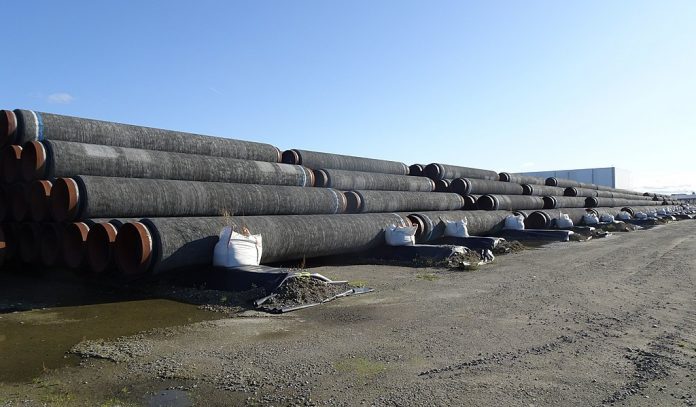Plans to expand America’s network of natural gas pipelines to meet surging domestic and global demand for reliable energy suffered a setback when the Federal Energy Regulatory Commission (FERC) issued sweeping requirements that will force pipeline developers seeking permits to meet a strict climate change threshold.
The new guidelines, issued February 17, incorporate climate change considerations into FERC’s permitting process as never before and promise to subject proposed gas pipeline projects to a new level of litigation and delays.
FERC, which oversees the interstate transmission of electricity, natural gas, and oil, is composed of five members, three Democrats and two Republicans. All three Democrats supported the change, the two Republicans opposed it.
In addition to considering the interests of the developer’s existing customers, the project’s effect on existing pipelines and customers, and its environmental impact, the new guidelines require an assessment of the proposed project’s impact on landowners, environmental justice populations, surrounding communities, and the long-term direct and indirect effects on climate change from greenhouse gas emissions.
FERC’s revisions serve as an administrative replacement for the far-reaching climate provisions contained in the Biden administration-backed Build Back Better legislation, which has stalled in Congress.
Carbon Emissions “Threshold”
For the first time, FERC is quantifying natural gas projects’ greenhouse gas emissions by creating a threshold that deems them “significant.”
Effective for both new and pending natural gas projects, FERC says that projects emitting at least 100,000 metric tons per year of carbon dioxide equivalent would “have a significant impact on the environment.” Projects exceeding this threshold could still be approved if FERC determines that the benefits outweigh the costs, but they would have to await the conclusion of an environmental impact statement (EIS), a process that is far lengthier than a less rigorous environmental assessment.
The commission’s new policy means developers will have “difficulty in securing capital for proposed projects,” said FERC member James Danly, in a vigorous dissent from the new rules.
“It is foreseeable that the result will be a reliability crisis in areas that need the gas the most,” Danly said in a statement. “This arises from the uncertain criteria to be applied by the Commission, the delays in obtaining the Commission’s approval, and the resulting increases in cost – including the cost of mitigation. Individually and collectively, these could be so severe that a natural gas company might not be able to accept the conditions of its certificate and proceed with a project that is otherwise needed to maintain reliability.”
‘Prioritizing a Political Agenda’
FERC’s new standards for pipeline approval are “reckless,” said Sen. Joe Manchin (D-WV), chairman the Senate Energy and Natural Resources Committee, in a statement.
“The Commission went too far by prioritizing a political agenda over their main mission – ensuring our nation’s energy reliability and security,” Manchin said. “The only thing they accomplished today was constructing additional road blocks that further delays building out the energy infrastructure our country desperately needs.
“Energy independence is our greatest geopolitical and economic tool and we cannot lose sight of that as instability rises around the world,” Manchin’s statement said.
FERC’s new guideline are “just the latest attack in Biden’s war on American energy,” said Sen. Sen. John Barrasso (R-WY), in a statement issued shortly after FERC issued its new rules.
“President Biden is trumpeting infrastructure at the same time his political appointees are working to kill energy infrastructure,” Barrasso said. “The Federal Energy Regulatory Commission is determined to make it nearly impossible for Americans to maintain or improve access to abundant and affordable supplies of natural gas.”
Inadequate Pipeline Infrastructure
Lack of sufficient natural gas infrastructure was a problem even before FERC adopted its new guidelines, says attorney Karen Moreau, former executive director of the American Petroleum Institute, New York.
“We are importing LNG from several countries into the Boston terminal due to the lack of pipeline capacity caused by then-New York Gov. Andrew Cuomo’s refusal to allow new pipelines,” said Moreau. “This has also led to a large increase of trucks on the road carrying propane to New England.
“The Tenneco gas pipeline terminates about 8 miles from my house near Albany, and that’s where they fuel up,” said Moreau. “So much for reducing emissions by increasing trucks on the road.”
Bonner R. Cohen, Ph.D., (bcohen@nationalcenter.org) is a senior fellow at the National Center for Public Policy Research and a senior policy analyst with the Committee for a Constructive Tomorrow.



























I thought that NEPA was the vehicle to determine environmental impacts and significance? This almost looks like a back door method to insure an EIS would be required on almost any pipeline project proposed…